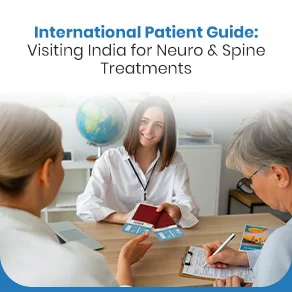_header.webp)
At IBS Hospital, we’re taking strides with our Deep Brain Stimulation program. Think of it as a gentle push towards better well-being, utilizing advanced technology. Our team is here to make life better, and we’re excited to explore the journey together for improved well-being and quality of life.
_thumbnail_1.webp )
_thumbnail_2.webp )
_thumbnail_3.webp )
What is Deep Brain Stimulation (DBS)?
Deep Brain Stimulation (DBS) is a surgical procedure where surgeons implant electrodes directly into specific areas of the brain. These electrodes deliver electrical impulses that block or alter the abnormal activity causing symptoms. Unlike other surgical options, an advantage of DBS is that it is reversible and does not cause permanent damage to any part of the brain.
What are the components of a Deep Brain Stimulation system and their respective functions?
The Deep Brain Stimulation system comprises four parts:
Leads: Thin insulated wires ending in electrodes, which are implanted in the brain.
Pulse Generator: A small pacemaker-like device that generates the electrical pulses.
Extension Leads: Wires that transmit electrical pulses from the pulse generator to the brain-implanted leads.
Programmer Device: A hand-held device used to adjust the signals of the system and to turn it off and on.
How does Deep Brain Stimulation work?
In the Deep Brain Stimulation system, electrodes are implanted in the targeted areas of the brain. These electrodes are connected by wires to a type of pacemaker device known as an implantable pulse generator, which is placed under the skin of the chest below the collarbone. Once activated, the pulse generator sends continuous electrical pulses to the target areas in the brain. This modifies the abnormal activity in those brain areas that are causing symptoms. The Deep Brain Stimulation system operates in a manner similar to a heart pacemaker. In fact, Deep Brain Stimulation is often referred to as ‘the pacemaker for the brain.
What kinds of Neurologic conditions can be treated with Deep Brain Stimulation?
Deep Brain Stimulation is approved by the Food and Drug Administration (USA) to treat a variety of movement and neurological disorders, including:
- Parkinsons disease
- Essential tremor
- Dystonia
- Epilepsy
- Obsessive-compulsive disorder
- Tourette syndrome
Who is a candidate for Deep Brain Stimulation (DBS) Surgery ?
Before being considered a candidate for Deep Brain Stimulation (DBS), patients must undergo an extensive evaluation process. Ideally, this involves assessment by a multidisciplinary team of specialists, including a neurologist,& neurosurgeon,& ;neuropsychologist, and psychiatrist.
Candidates for DBS are generally patients who meet the following criteria:
- Their symptoms are not well-controlled despite receiving the appropriate doses of medications.
- Their symptoms significantly reduce their quality of life.
- They cannot tolerate the side effects of their current medications.
What are the advantages of Deep Brain Stimulation (DBS)?
Deep Brain Stimulation (DBS) offers several advantages:
- Unlike some other surgical options, DBS does not cause permanent damage to any part of the brain.
- The electrical stimulation is adjustable and reversible. This adaptability accommodates changes in the patient’s disease progression or response to medications.
- Due to its reversibility and lack of permanent brain damage, DBS may allow for the use of innovative treatment options that may emerge in the future.
- The stimulator can be turned off at any time. If DBS causes excessive side effects, this can be done without any long-term consequences.
How should I care for the Surgical area once I am home?
- Your stitches or staples will be removed 10 to 14 days after surgery.
- Keep each of the four pin sites covered with band-aids until they are dry. Change these band-aids daily as necessary.
- You can wash your head with a damp cloth while avoiding the surgical area.
- You may shampoo your hair very gently the day after your stitches or staples are removed.
- You should avoid scratching or irritating the wound areas.
When would I need to call my doctor?
Call your doctor immediately if you experience any of the following symptoms:
- Experiencing severe and persistent headaches.
- Bleeding from your incision.
- Redness or increased swelling in the area of the incision.
- Loss of vision.
- A sudden change in vision.
- A persistent body temperature of 101 degrees Fahrenheit or higher.
IBS Hospital Empowers Your Treatment with Cutting-edge Technology
We continuously incorporate cutting-edge technologies from around the world into our offerings, such as a surgical system that allows for precise and confident complex procedures. We use magnetic stimulation to treat certain neurological conditions and create personalised brain maps for tailored treatment plans. Nerve monitoring during surgeries ensures the nervous system is not compromised, and a robotic exoskeleton aids in mobility issues. Our goal at IBS Hospital is to provide the best care possible, utilising the latest and most innovative technologies available.







